Pride of Madiera is the Common name given to the Echium fatuosum, and as the name suggests, it is native to the Island of Madiera. This is a large perennial plant with rough , raspy textured leaves, and large blue flowers spikes in Spring to early Summer.
There are a number of varieties of Echium, and they are all spectacular when in flower, adding a distinct shape in a garden which contrasts to other plants. The plants grow to around 2.5 metres tall, and around 2 metres wide, and are drought tolerant once established. The best climate for these is temperate to warm, preferably with low humidity, although Sydney can be quite humid in Summer, and these plants still look good. Plant them in a position with full sun and well drained soil. Prune off old flower heads and leggy stems to keep the plant compact. They grow fast, so they will look good again in no time.
I took these photos in gardens close to Sydney Harbour. 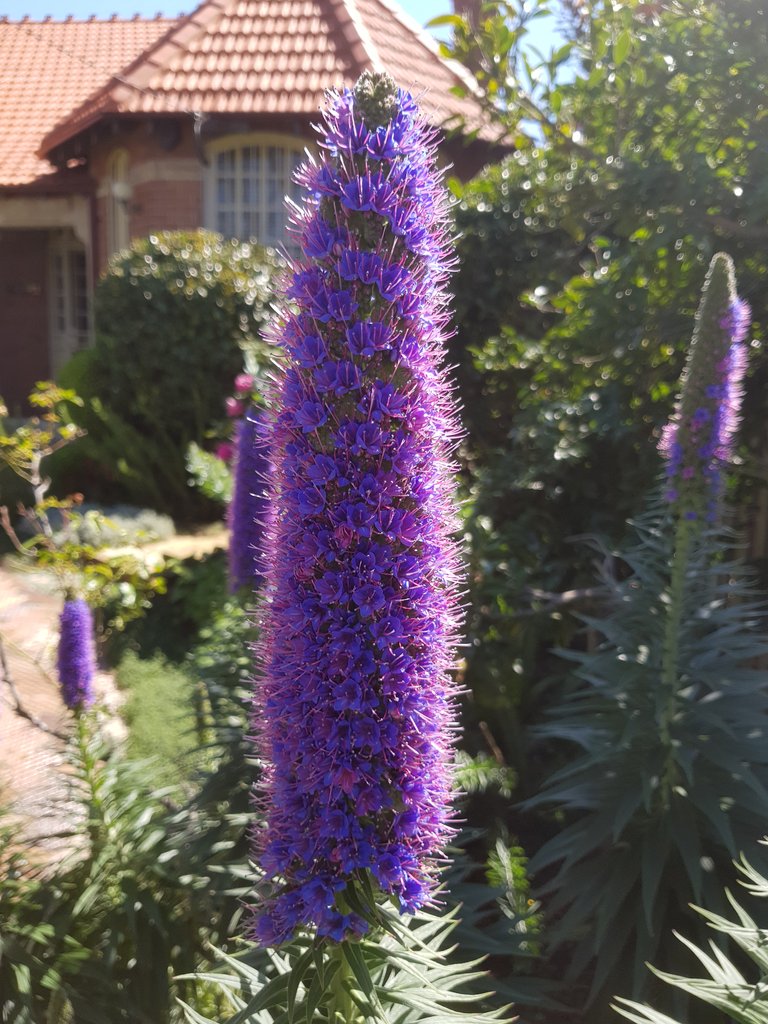
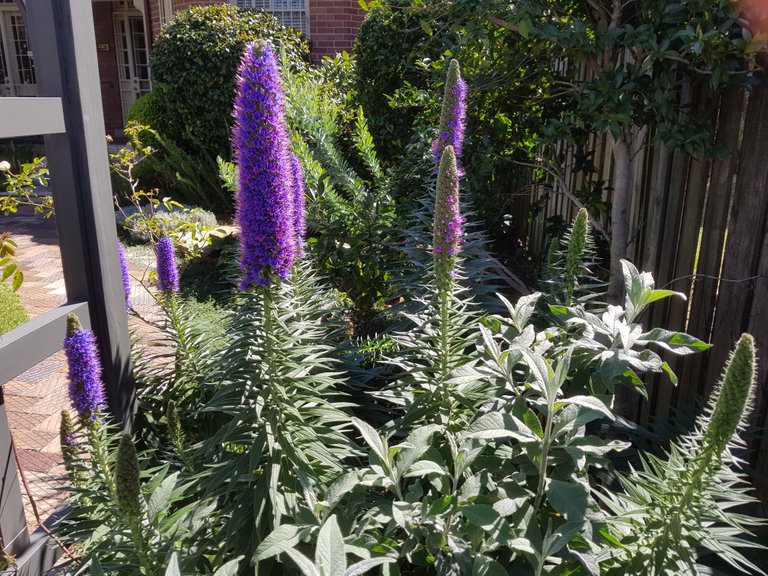

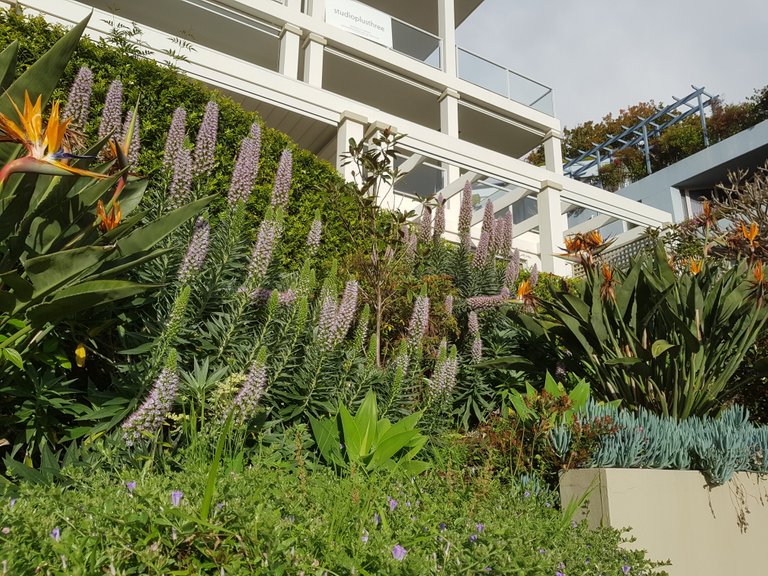
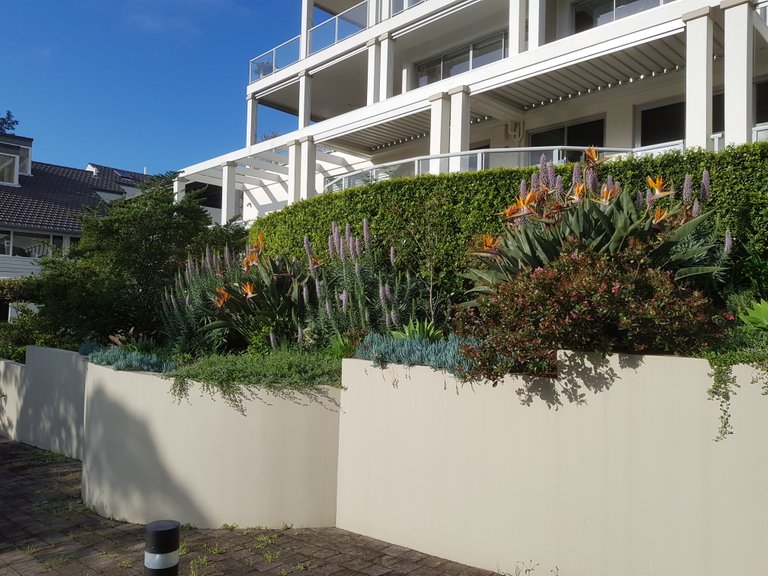
A very beautiful plant. I fell in love with it. It really is the pride of all the representatives of this family. Pride of Madeira. This delightful and hardy perennial produces large spires of sapphire blue to violet flowers with crimson stamens in spring and summer. Best grown in the ground and

great in cottage gardens or in mixed borders. Grows well in coastal areas and is great for bees.
Thank you for the wonderful plants.
https://inlandvalleygardenplanner.org/plants/page/15/
Fav. comment Award ! Nice choice of Pics, well done.
Madeira's pride is a beautiful and amazing plant. This is truly dramatic with spectacular high flower spikes.
This beautiful plant needs one season for flower germination so it will flower in the first year and so on.
After the flower is formed, Madeira's pride will produce its own seeds productively. Unless we have winter, we will never plant again because we will always have lots of seeds.
In the first year, Madeira's pride will grow by about one meter and in the second year will produce fantastic flowers.
Absolutely spectacular!
Source
Fav. comment Award ! Excellent Pics, thanks.
We love that this old classic is coming back in popular demand. The Pride of Madeira is an excellent prolific flowering plant with gorgeous and tall purple flowers.If you’re looking for a low maintenance flowering plant with maximum impact, this plant might be just what you’re after. It’s a perennial and grows excellently in Australian coastal areas, requiring minimal watering and care.
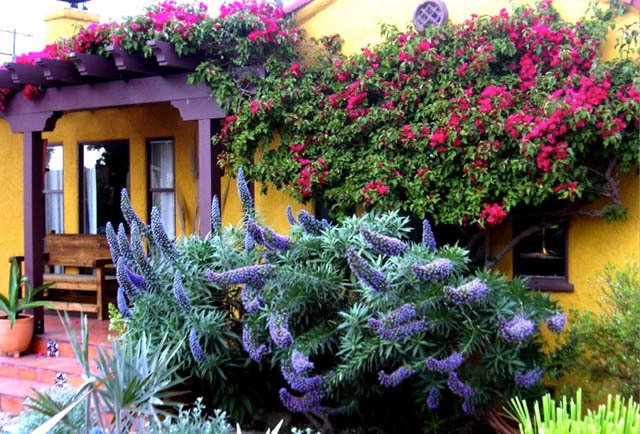
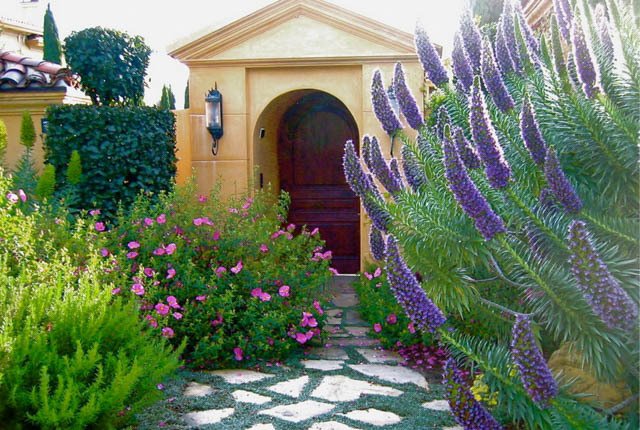
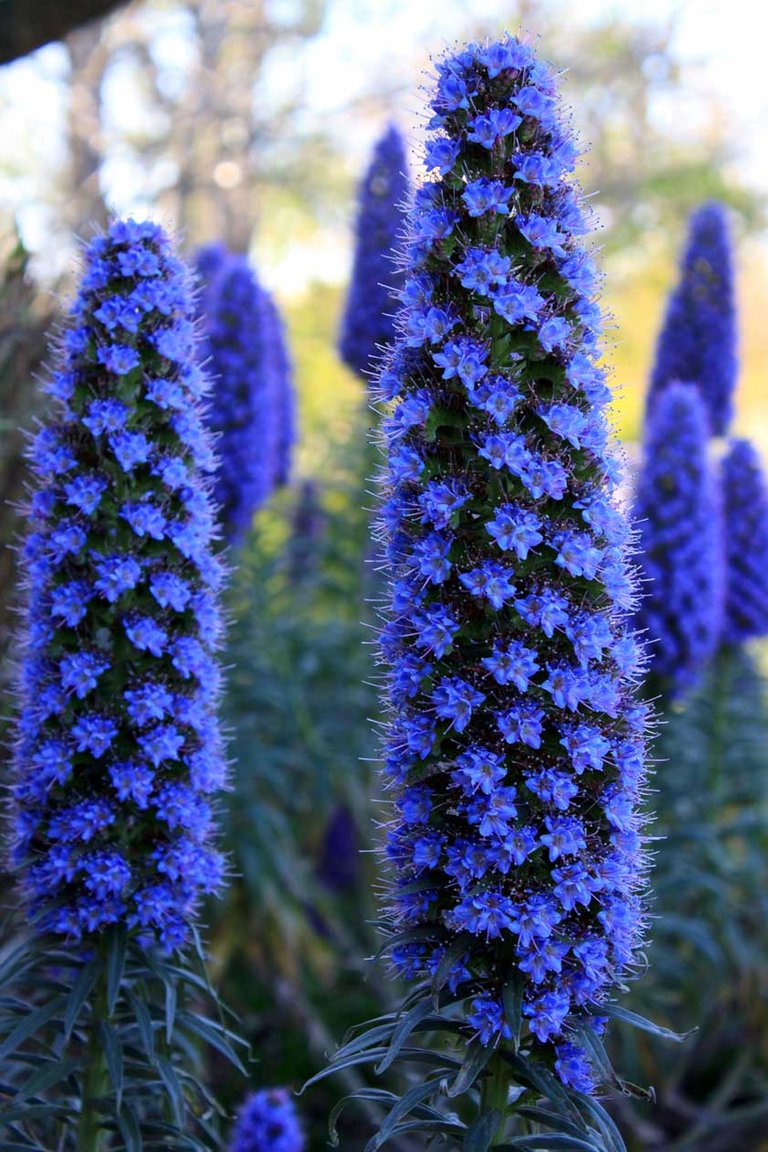
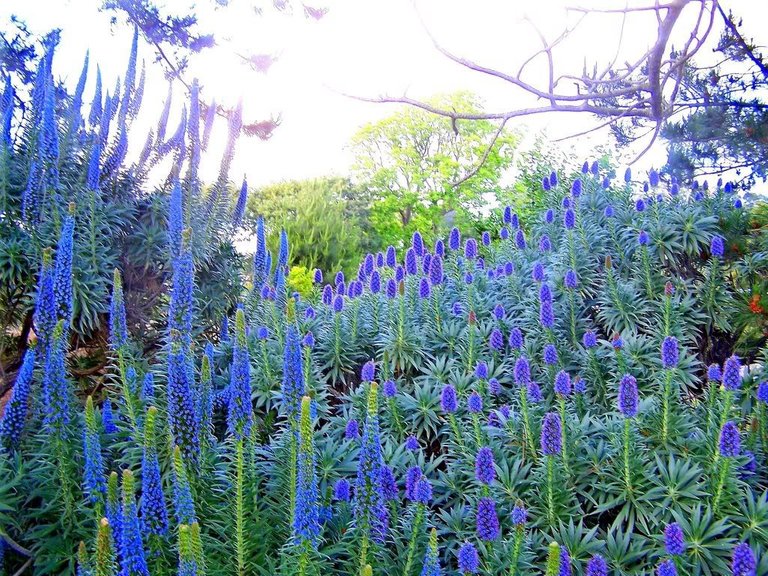
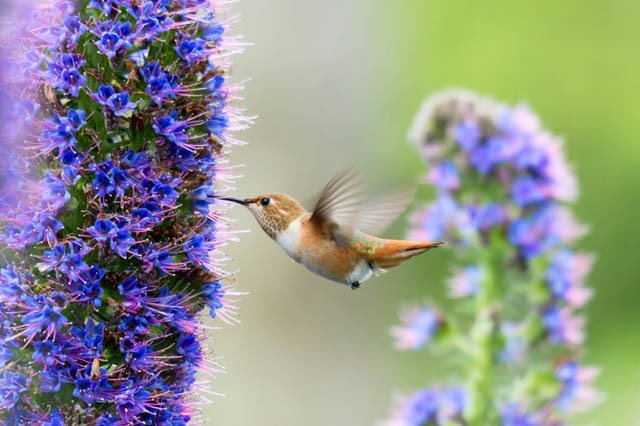 .
.
Reaching a maximum of about 3 metres tall and 2 meters wide, the Echium Candicans grows best in full sun. Soil should be well drained and not too rich or moist. For care, once flowering has finished prune off the flower spikes. This will encourage growth of more branches for next.
We like the idea of making a bold colour and size statement with this plant. Once you see this plant in all it’s glory, well placed in any garden setting, it is hard to forget. We recommend planting the Pride of Madeira in an area which allows plenty of space for it to grow. We would also advise planting it at the back of your garden beds so it doesn’t over shade other plants.
Source.  - A rapidly growing evergreen shrub to 4 to 6 feet or more tall or more by as wide with long, narrow, gray-green leaves held at the ends of the branches. Rising above the foliage in spring on into early summer are the large 20 inch long flower stalks bearing small bluish-purple flowers with reddish stamens. Plant in full sun in most any type of soil and irrigate occasionally to not at all. Once established plants require no additional irrigation in coastal gardens though inland plantings will appreciate occasional irrigation and protection from cold - reliably cold hardy for short durations down to about 25 degrees F and some claim a bit colder. This is a great plant for mild coastal climates and seaside gardens on a slope or in an area with room to spread out and it is attractive to honey bees, hummingbirds and butterflies, but unpalatable to deer and other browsers. Pride of Madeira often reseeds itself in the garden and, as this plant is relatively short lived (generally 4-6 years but some living up to 10 years), allow seedlings to replace older woodier plants. Prune flower inflorescences off after flowering to tidy up the plant and cut back hard in late fall to reduce size and encourage new growth from lower branches - leaves have slightly irritating hairs so remember to wear gloves when handling.
https://www.smgrowers.com/products/plants/plantdisplay.asp?plant_id=543
Twelve inch spikes of countless purple-blue flowers open on strong branching stems in spring and summer, although very few good seeds are often produced. This really is a perennial in a sheltered situation, e.g. in a large pot or a very protected garden. In The Scilly Islands and the South West of the UK this plant often makes a long-lived small tree.
Seeds are best sown in spring or before mid summer to enable a full season of growth and are best sown where actually needed, preferably in a well-drained and sheltered spot. Otherwise, sow seeds, covering very thinly, in early spring onto a good soil-based compost in a frost-free place. No artificial heat is needed to help germinate these seeds, just a cool, varying, background temperature, in good light. Seedlings usually appear in 3 to 4 weeks. Pot on into a gritty compost containing very little organic material before planting out as small plants in a well-drained sheltered spot, or a large container that may be taken in during the winter in severe frost. Plants usually flower 24 months after sowing and can occasionally vary in habit and flower colour as we have numerous species growing here, and very many busy bees.
https://www.plant-world-seeds.com/store/view_seed_item/447
Wow it's beautiful! Uncommon in Sri Lanka! Actually I never see this plant and flower here! It seems to be a good plant for gardening and your photography has proven it! Thank you for sharing such great photography and description about "Pride of Madiera"!@ctrl-alt-nwo,
Cheers~
Your post was mentioned in the Steemit Hit Parade in the following category:Congratulations @ctrl-alt-nwo!
Beautiful plant, my friend, a truly dramatic garden plant, a close relative of borage, it produces the most spectacular tall flower spikes seemingly from nowhere in summer. Despite it's common name of 'Pride of Madeira', it is hardy in the UK down to -5C or so, particularly where it is drier in winter. It is biennial, so needs one cold winter after germination to flower - so these plants will flower in their first year and beyond.
Once your echium has established and flowered, it will self-seed prolifically and, unless we have a really harsh winter, you will never have to plant another as you will always have plenty of seedlings!
E. candicans will grow to around 1m (3ft) in its first year, then in its second, it produces its magnificent flower - in milder areas the plants keep growing all year around and, after a frost-free winter, you will see enormous flower spikes. Plants are not frost hardy, and the leaves are easily blackened by cold winds so protect seedlings and one-year old plants if frost threatens.
A common sight in Cornwall as well, Echiums are best grown in very well drained soils, or in large pots with plenty of sand or grit for drainage. When it does grow in spring, keep it well watered between May and August as it grows quickly.
Echiums self-seed over a small area, and once these seedlings have germinated and over-wintered, they too may flower away, and a little colony will appear. Truly spectacular and one of the best plants that you can grow to attract pollinating insects into your garden.
Thank you @ctrl-alt-nwo
A source of information: https://www.yougarden.com/item-p-680023/pride-of-madeira-echium-candicans
Thanks again for sharing some great photos.
Shared on twitter promoting #Steemit.
Have a great weekend.
Stephen
Pride of Madiera. #STEEM #steemtalent #JoinSteemit #Steemit
#garden #gardening #gardensworld #plant #life #blog #blogger #australia #photography #photographer
A truly dramatic garden plant, a close relative of borage, it produces the most spectacular tall flower spikes seemingly from nowhere in summer. Despite it's common name of 'Pride of Madeira', it is hardy in the UK down to -5C or so, particularly where it is drier in winter. It is biennial, so needs one cold winter after germination to flower - so these plants will flower in their first year and beyond.
E. candicans will grow to around 1m (3ft) in its first year, then in its second, it produces its magnificent flower - in milder areas the plants keep growing all year around and, after a frost-free winter, you will see enormous flower spikes. Plants are not frost hardy, and the leaves are easily blackened by cold winds so protect seedlings and one-year old plants if frost threatens.
A common sight in Cornwall as well, Echiums are best grown in very well drained soils, or in large pots with plenty of sand or grit for drainage. When it does grow in spring, keep it well watered between May and August as it grows quickly.
Echiums self-seed over a small area, and once these seedlings have germinated and over-wintered, they too may flower away, and a little colony will appear. Truly spectacular and one of the best plants that you can grow to attract pollinating insects into your garden.
Source
An exotic shrub. That should be any oxymoron. How could something as exotic and beautiful as this be described as something as dull as 'a shrub'? This can. No alternative. It's woody and the trunk and branches tend to create the most wonderful shapes under its canopy of floppy glaucous leaves and in early spring starts producing it's crowd of perpendicular electric blue flower spikes. Fully out in April. The plant might reach 6ft or more (still doesn't qualify as a tree) and 6ft across and the flowers about 1ft tall. If you have a garden mild enough for this (within 200 metres of the beech or Central London), one of its many engaging traits is its tendency to produce the flowers even in the depths of winter. A harbinger of spring, a nice reminder that winter won't last forever. It's just before Christmas as I write and the plants at the nursery (in the unheated greenhouse) are already making it obvious where they're going to flower.
It needs plenty of light, good ventilation and a reasonably well drained soil. If you can give it winter protection (a shed or greenhouse), try it in a pot but make it as big as you can manage. They grow quite fast but don't live particular long (10 years?). A roof garden in Central London... The main one pictured is in Linda's garden in Felpham - 100 yards from the beach. Linda is our Niwaki expert.
Source: http://architecturalplants.com/plants/id/echium-fastuosum
An exotic shrub. That should be any oxymoron. How could something as exotic and beautiful as this be described as something as dull as 'a shrub'? This can. No alternative. It's woody and the trunk and branches tend to create the most wonderful shapes under its canopy of floppy glaucous leaves and in early spring starts producing it's crowd of perpendicular electric blue flower spikes. Fully out in April. The plant might reach 6ft or more (still doesn't qualify as a tree) and 6ft across and the flowers about 1ft tall. If you have a garden mild enough for this (within 200 metres of the beech or Central London), one of its many engaging traits is its tendency to produce the flowers even in the depths of winter. A harbinger of spring, a nice reminder that winter won't last forever. It's just before Christmas as I write and the plants at the nursery (in the unheated greenhouse) are already making it obvious where they're going to flower.
http://architecturalplants.com/plants/id/echium-fastuosum
Reaching a maximum of about 3 metres tall and 2 meters wide, the Echium Candicans grows best in full sun. Soil should be well drained and not too rich or moist. For care, once flowering has finished prune off the flower spikes. This will encourage growth of more branches for next season!
We like the idea of making a bold colour and size statement with this plant. Once you see this plant in all it’s glory, well placed in any garden setting, it is hard to forget. We recommend planting the Pride of Madeira in an area which allows plenty of space for it to grow. We would also advise planting it at the back of your garden beds so it doesn’t over shade other plants.
Source
Those look even beautiful in the long fields when they are at their best beautiful to check out about it
Very nice deep colour flowers! This will grow up to two meters! But it requires a lot of work too.
Posted using Partiko iOS
Still a beautiful plant @ctrl-alt-nwo despite its unusual raspy shape but the colors are stunning if you look closely on the flowers.
Fantastic. I never even imagined a plant like this looks artificial but very beautiful.
Set of flowers for sure. And i want to call these flowers as Cone Flowers. And whenever we watch these kind of Natural Artistic Creations then in my opinion it reflects as nature created these plants to grow the pure and natural Decorative Pieces. And in these pictures we can see that how beautifully these plants are enhancing the house and for sure these pictures will going to encourage others to adopt the Home Based Plantation idea. Keep capturing and sharing healing aspects of nature.@ctrl-alt-nwo, What can i say about this plant, just wow and awesome. This plant have beautiful and very unique
Wishing you an great day and stay blessed. 🙂
ECHIUM 'BLUE DWARF'
KEY FACTS
Family:Boraginaceae
Common name:Echium fastuosum hybrid
Classification:Half hardy perennial
Height:1.0-1.3m
Packet Content:15 (Approx)
DESCRIPTION
This dazzling, completely new, diminutive form of this delightful plant appeared by chance in our gardens at Plant World. Probably an Echium fastuosum/pininana hybrid, it is best grown under the shelter of a hedge or wall and facing the sun, where it makes a low mound of several hairy, grey-green rosettes on numerous branching stems. Stumpy, fat spikes of cobalt-blue flowers open from April to June producing an awe-inspiring spectacle. To perform well it needs protection from cold winds and severe frost though! A limited number of good seeds were collected. (All of our echiums are grown in the same large gardens at Plant World, so you may occasionally have a % of hybrids.)
SOWING ADVICE
Seeds are best sown in spring or before mid summer to enable a full season of growth and are best sown where actually needed, preferably in a well-drained and sheltered spot. Otherwise, sow seeds, covering very thinly, in early spring onto a good soil-based compost in a frost-free place. No artificial heat is needed to help germinate these seeds, just a cool, varying, background temperature, in good light. Seedlings usually appear in 3 to 4 weeks. Pot on into a gritty compost containing very little organic material before planting out as small plants in a well-drained sheltered spot, or a large container that may be taken in during the winter in severe frost. Plants usually flower 24 months after sowing and can occasionally vary in habit and flower colour as we have numerous species growing here, and very many busy bees....
https://www.plant-world-seeds.com/store/view_seed_item/4777
Echium fastuosum
An exotic shrub. That should be any oxymoron. How could something as exotic and beautiful as this be described as something as dull as 'a shrub'? This can. No alternative. It's woody and the trunk and branches tend to create the most wonderful shapes under its canopy of floppy glaucous leaves and in early spring starts producing it's crowd of perpendicular electric blue flower spikes.
Fully out in April. The plant might reach 6ft or more (still doesn't qualify as a tree) and 6ft across and the flowers about 1ft tall. If you have a garden mild enough for this (within 200 metres of the beech or Central London), one of its many engaging traits is its tendency to produce the flowers even in the depths of winter.
A harbinger of spring, a nice reminder that winter won't last forever. It's just before Christmas as I write and the plants at the nursery (in the unheated greenhouse) are already making it obvious where they're going to flower.
It needs plenty of light, good ventilation and a reasonably well drained soil. If you can give it winter protection (a shed or greenhouse), try it in a pot but make it as big as you can manage. They grow quite fast but don't live particular long (10 years?). A roof garden in Central London.
References12345
Echium candicans (syn. Echium fastuosum is commonly known as pride of Madeira, is a species of flowering plant in the family Boraginaceae, native to the island of Madeira. It is a large herbaceous Perennial subshrub, growing to 1.5–2.5 m.
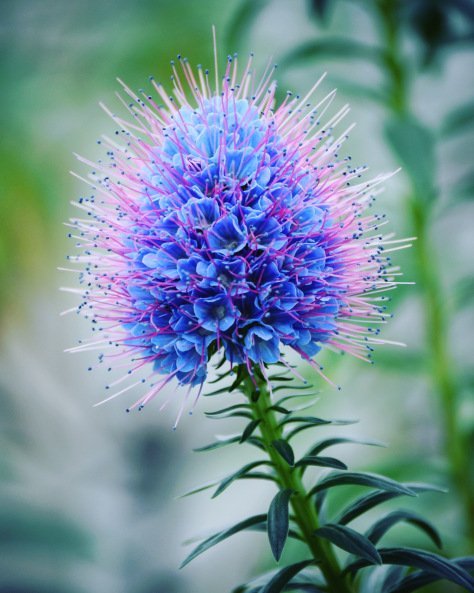
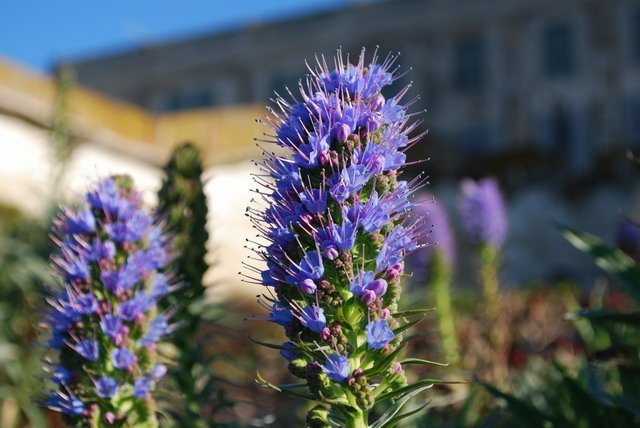
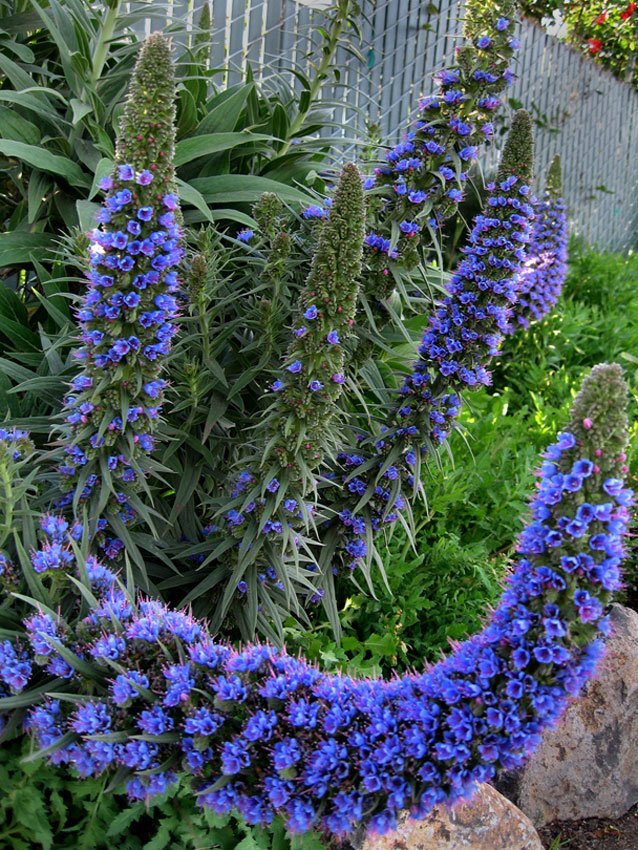
Source
Source
Source
In the first year after germination the plant produces a broad rosette of leaves. In the second and subsequent years more or less woody flowering stalks are produced clothed in rough leaves. The flower head is large and covered with white or blue flowers having red stamens. It is much visited by bees and butterflies for its nectar.
Source
magoo-2 found a series of multi accounts of a same owner is following your articles to cheat your generous rewards.
magoo-2 found these accounts are suspicious & can be multi accounts of a single owner. Conclusion is based on last 1 year transactions:
@alves @devid1996 @mhyeasin @sadikulaziz @msena @kilee @ripon1 @googlefighter @melianasagita @ashasikder @hichako
magoo-2
Check our latest multi comment spam update report
Echium fastuosum
An exotic shrub. That should be any oxymoron. How could something as exotic and beautiful as this be described as something as dull as 'a shrub'? This can. No alternative. It's woody and the trunk and branches tend to create the most wonderful shapes under its canopy of floppy glaucous leaves and in early spring starts producing it's crowd of perpendicular electric blue flower spikes. Fully out in April. The plant might reach 6ft or more (still doesn't qualify as a tree) and 6ft across and the flowers about 1ft tall. If you have a garden mild enough for this (within 200 metres of the beech or Central London), one of its many engaging traits is its tendency to produce the flowers even in the depths of winter. A harbinger of spring, a nice reminder that winter won't last forever. It's just before Christmas as I write and the plants at the nursery (in the unheated greenhouse) are already making it obvious where they're going to flower.
It needs plenty of light, good ventilation and a reasonably well drained soil. If you can give it winter protection (a shed or greenhouse), try it in a pot but make it as big as you can manage. They grow quite fast but don't live particular long (10 years?). A roof garden in Central London... The main one pictured is in Linda's garden in Felpham - 100 yards from the beach. Linda is our Niwaki expert.
For information and ideas on winter protection go to 64. Wrapping for Winter in the Glossary of Terms.
Propagated by us from seed.
http://architecturalplants.com/plants/id/echium-fastuosum
Nice, i didn't know this before looking very nice
It maybe Beautiful but consider as Weeds in the state of Victoria.
@ctrl-alt-nwo beautiful photo I've born in Portugal and I suggest another lovely flower from Madeira Island.
The Strelitzia reginae flower has a unique shape similar to the head of a bird, hence also known as the Bird of Paradise.
It is the national flower of Madeira, Portugal since 2005.
Posted using Partiko Android
2,5 meters is high, but beautiful👍
Delightful plant. One of the most unusual plants I've ever seen.
Echium fastuosum is an exotic shrub. That should be any oxymoron. How could something as exotic and beautiful as this be described as something as dull as 'a shrub'? This can. No alternative. It's woody and the trunk and branches tend to create the most wonderful shapes under its canopy of floppy glaucous leaves and in early spring starts producing it's crowd of perpendicular electric blue flower spikes. Fully out in April. The plant might reach 6ft or more (still doesn't qualify as a tree) and 6ft across and the flowers about 1ft tall. If you have a garden mild enough for this (within 200 metres of the beech or Central London), one of its many engaging traits is its tendency to produce the flowers even in the depths of winter. A harbinger of spring, a nice reminder that winter won't last forever. It's just before Christmas as I write and the plants at the nursery (in the unheated greenhouse) are already making it obvious where they're going to flower.
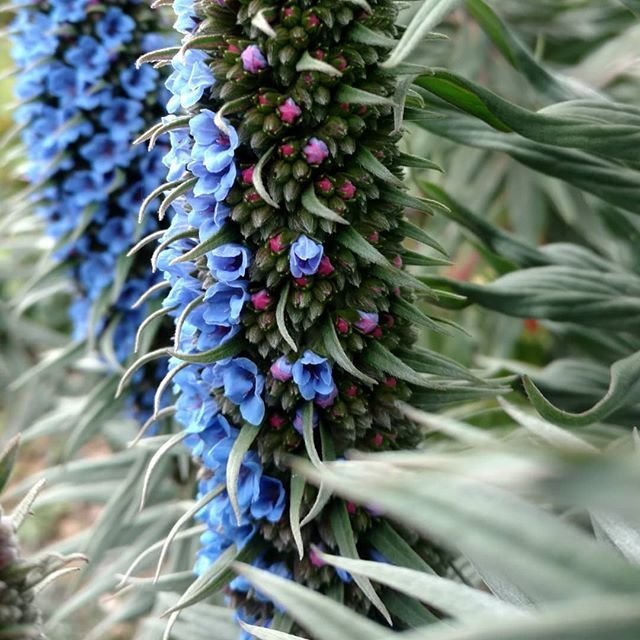
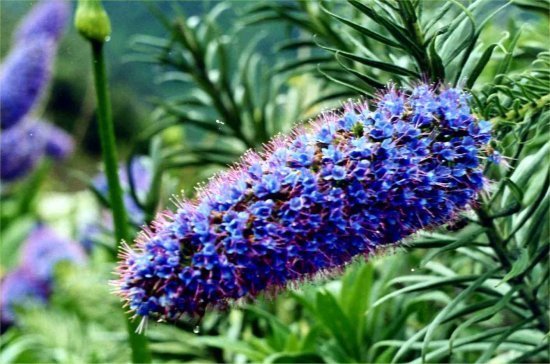
image source
image source
It needs plenty of light, good ventilation and a reasonably well drained soil. If you can give it winter protection (a shed or greenhouse), try it in a pot but make it as big as you can manage. They grow quite fast but don't live particular long.
content source
Pride of Madeira
Echium candicans, a dicot, is a shrub that is not native to California; it was introduced from elsewhere and naturalized in the wild.
Location Suitability
Distribution by County
Family: BORAGINACEAE
Genus: Echium
https://www.calflora.org/cgi-bin/species_query.cgi?where-calrecnum=2888
Huge, dramatic, blue-purple spikes appear on the end of upward curving branches in Spring. Does well in POOR, DRY SOIL, but does need drainage. 3’-6’ tall and wide. No summer water in Sunset Zones 16-17 needed once established. Native to the Madeira Island, north of the Canary Islands.
Their flower spikes, each of which contains thousands of individual blossoms, attract butterflies, bees and hummingbirds in droves. You’ll see them not only in blue, but in many shades of purple and lavender, as well as a dusty pink.
https://leisureguy.wordpress.com/2010/03/20/pride-of-madeira/
Echium candicans (Pride of Madeira) - A rapidly growing evergreen shrub to 4 to 6 feet or more tall or more by as wide with long, narrow, gray-green leaves held at the ends of the branches. Rising above the foliage in spring on into early summer are the large 20 inch long flower stalks bearing small bluish-purple flowers with reddish stamens. Plant in full sun in most any type of soil and irrigate occasionally to not at all.
source
magoo-2 found a series of multi accounts of a same owner is following your articles to cheat your generous rewards.
magoo-2 found these accounts are suspicious & can be multi accounts of a single owner. Conclusion is based on last 30 days transactions:
@itamarr @chocosteem @berwyn @benedetto @bronter @hungduan
magoo-2
Check our latest multi comment spam update report
We love that this old classic is coming back in popular demand. The Pride of Madeira is an excellent prolific flowering plant with gorgeous and tall purple flowers.
If you’re looking for a low maintenance flowering plant with maximum impact, this plant might be just what you’re after. It’s a perennial and grows excellently in Australian coastal areas, requiring minimal watering and care.
Reaching a maximum of about 3 metres tall and 2 meters wide, the Echium Candicans grows best in full sun. Soil should be well drained and not too rich or moist. For care, once flowering has finished prune off the flower spikes. This will encourage growth of more branches for next season!
We like the idea of making a bold colour and size statement with this plant. Once you see this plant in all it’s glory, well placed in any garden setting, it is hard to forget. We recommend planting the Pride of Madeira in an area which allows plenty of space for it to grow. We would also advise planting it at the back of your garden beds so it doesn’t over shade other plants.
http://www.adamrobinsondesign.com/blog-posts/plant-of-the-month-pride-of-madeira
magoo-2 found a series of multi accounts of a same owner is following your articles to cheat your generous rewards.
magoo-2 found these accounts are suspicious & can be multi accounts of a single owner. Conclusion is based on last 1 year transactions:
@jacqueline5 @african1 @merina @marizanne @miller1 @jerry1994 @aarshi @nawmi @maisha @jenifer2 @masud1 @jerry2 @selina2 @bingham @mulder2000 @umess @neerose123 @diaa07
magoo-2
Check our latest multi comment spam update report
FABULOUS,today,s photography is telling you are a good photographer the flower are very beautiful for garden as well as front decor of house.
A fast growing, coastal perennial shrub with spectacular 60cm long, violet blue flower spires, blooming in winter and spring. This frost hardy, evergreen species needs a sunny position with well drained, ordinary soil and a Mediterranean climate. Drought and salt tolerant.
AC_SS350.jpghttps://images-na.ssl-images-amazon.com/images/I/71lrklnxmtL.
source
magoo-2 found a series of multi accounts of a same owner is following your articles to cheat your generous rewards.
magoo-2 found these accounts are suspicious & can be multi accounts of a single owner. Conclusion is based on last 1 year transactions:
@saikr @christian.danny @aaeesha @sarah.taylor
magoo-2
Check our latest multi comment spam update report
First and foremost is the perennial shrub called pride of Madeira, Echium candicans or Echium fastuosum, which sports gorgeous cone-shaped flower spikes this time of year. You’ll see these plants blooming profusely from now through May.
Their flower spikes, each of which contains thousands of individual blossoms, attract butterflies, bees and hummingbirds in droves. You’ll see them not only in blue, but in many shades of purple and lavender, as well as a dusty pink.
Pride of Madeira, which can be found in gardens and along roadsides all over the Central Coast, is native to Portugal’s Madeira Island. Because it flourishes in Mediterranean climates and likes dry conditions, it is perfectly suited to our part of California.
In fact, pride of Madeira does best when left alone, preferably in poor soil and with little water — a lazy gardener’s dream. Rich soil and too much moisture are actually detrimental to the plant and can kill it. Some sources say it doesn’t do well in clay soil, and too much shade will keep the plant from blooming.
Pride of Madeira reseeds freely and so it’s easy to get babies if you have a friend with mature plants. Plants also can be started from cuttings. They’ll require occasional water during the first summer in order to get established, but after that need little or no care.
The only caveat with pride of Madeira is that the plants tend to get very large very fast. They can easily grow 10 feet tall and 10 feet wide within two to three years. Experts recommend pruning or pinching back once or twice during the year to maintain shape and keep the plant from getting lanky.
https://leisureguy.wordpress.com/2010/03/20/pride-of-madeira/
Large 20 inch long flower stalks bearing small bluish-purple flowers with reddish stamens in spring and summer. This plant is short lived (generally 5-6 years but can go longer), so allow seedlings to replace older woodier plants. Can be invasive.
source
magoo-2 found a series of multi accounts of a same owner is following your articles to cheat your generous rewards.
magoo-2 found these accounts are suspicious & can be multi accounts of a single owner. Conclusion is based on last 1 year transactions:
@saikr @christian.danny @aaeesha @sarah.taylor
magoo-2
Check our latest multi comment spam update report
Madeira, 37 miles in length and 14 miles wide, impressively possesses topographical characteristics of both California’s North and South. Because of its high elevations and peaks, Madeira boasts a sub tropic climate such as that of Northern California. In fact, the Du-Cane’s describle Madeira’s 6000 foot peaks as a “miniature” landscape, and similar to the “grandeur to that of the Yosemite Valley.”
Meanwhile, Madeira’s proximity to Africa lends a dry climate similar to Southern California’s arid landscape. And while we suffer the Santa Anas, Madeira, like its southern European neighbors, bears the “Leste,” a hot south Eastern wind blowing from the Sahara. It’s no wonder we have so many of the same plant varieties, to wit, the Datoura (and deadly!) trumpets; the ethereal Jacaranda buds that carpet our streets in June; December’s holiday-ish Flamboyants, better known as Poinsettias; the ever charismatic Purple Bougainvillea “creeper” that subsumes our porticos. And for a brief period each Spring, the brave and the bold purplish-blue Pride of Madeira.

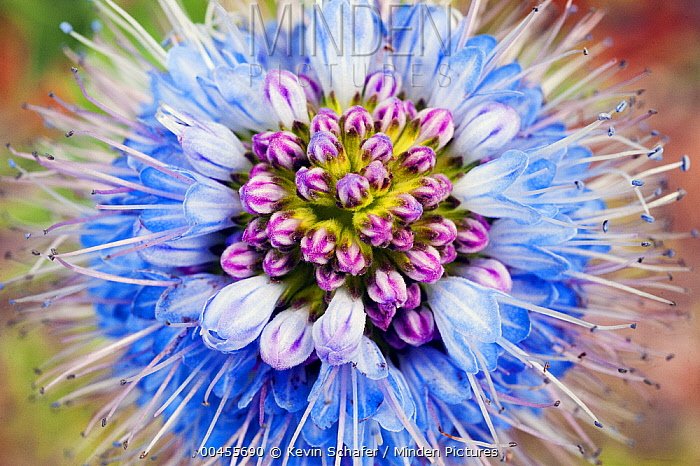
http://www.malibutimes.com/blogs/article_36f0ce20-b5aa-11e2-a100-0019bb2963f4.html
magoo-2 found a series of multi accounts of a same owner is following your articles to cheat your generous rewards.
magoo-2 found these accounts are suspicious & can be multi accounts of a single owner. Conclusion is based on last 1 year transactions:
@jacqueline5 @african1 @merina @marizanne @miller1 @jerry1994 @aarshi @nawmi @maisha @jenifer2 @masud1 @jerry2 @selina2 @bingham @mulder2000 @umess @neerose123 @diaa07
magoo-2
Check our latest multi comment spam update report
his plant is absolutely gorgeous! Need I say more? The picture above summarizes it nicely. Most people are more familiar with Echium wilpretti which has red flowers. These are striking, but grow larger and don't tend to branch into the attractive plant that the blue species does.
As the name suggests, this plant is native to the island of Madeira. This is owned by Portugal and located off the coast of Morocco. It's tolerant of coastal exposure and salt spray but requires well drained soil. These Echium typically reach a height of 2m and bloom in the spring. They can take freezing temperatures and are considered hardy to USDA zone 9a.
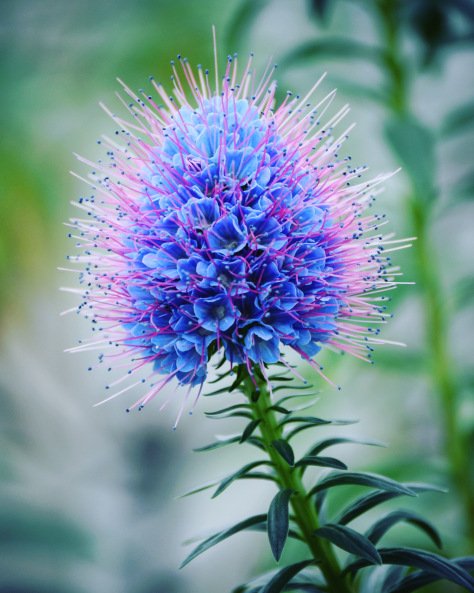
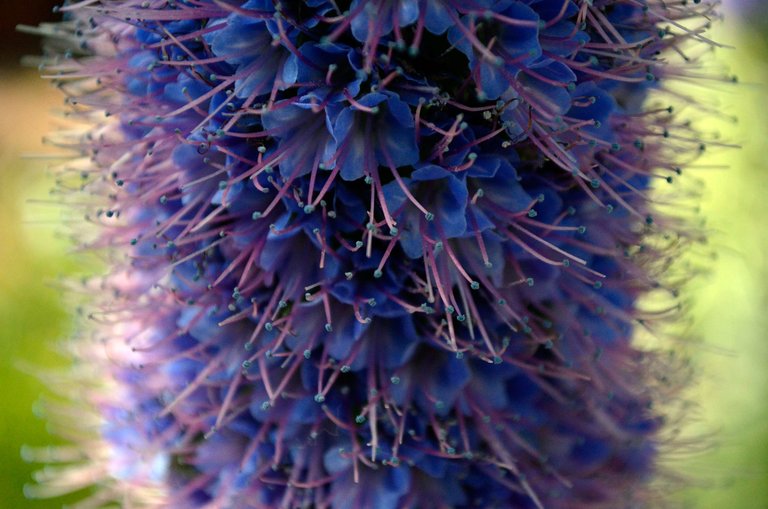
Seeds germinate readily and most should have sprouted within 2 weeks. They should be sown in a well drained potting mix, about 1/2cm deep and at room temperature. Plants establish themselves the first year and then reward you with flowers thereafter. If stressed they may only last two years but are generally considered a perennial.
http://plant-zone.blogspot.com/2011/10/germinating-pride-of-madeira-echium.html
magoo-2 found a series of multi accounts of a same owner is following your articles to cheat your generous rewards.
magoo-2 found these accounts are suspicious & can be multi accounts of a single owner. Conclusion is based on last 1 year transactions:
@jacqueline5 @african1 @merina @marizanne @miller1 @jerry1994 @aarshi @nawmi @maisha @jenifer2 @masud1 @jerry2 @selina2 @bingham @mulder2000 @umess @neerose123 @diaa07
magoo-2
Check our latest multi comment spam update report
Beautiful plant . Flowers colors and it's height are just amazing.. this plant looks different in many plants . Very suitable name "Pride of Madiera'
Brilliant plant. A standout amongst the most uncommon plants I have ever observed.
On our last visit to the Gamble Garden in Palo Alto, we came across an impressive cluster of thick stems (clearly some years old) standing about 3 feet tall, with conical clusters of buds at the top of the stems. The only label we could find was for an obviously irrelevant plant (a daisy-like composite).
But then this morning we went back, and it was in gorgeous purple-blue bloom. Back home, I thought to try a strategy that almost never works in Google searches: describing the plant (“tall spires of purple flowers”), but this time I hit paydirt right away, with a page devoted to plants with tall stalks of purple/blue flowers.
https://arnoldzwicky.org/2017/03/28/pride-of-madeira/
magoo-2 found a series of multi accounts of a same owner is following your articles to cheat your generous rewards.
magoo-2 found these accounts are suspicious & can be multi accounts of a single owner. Conclusion is based on last 1 year transactions:
@jacqueline5 @african1 @merina @marizanne @miller1 @jerry1994 @aarshi @nawmi @maisha @jenifer2 @masud1 @jerry2 @selina2 @bingham @mulder2000 @umess @neerose123 @diaa07
magoo-2
Check our latest multi comment spam update report
Beautiful plant for home garden . Flowers are amazing . This plant is pride of garden. I am first time seeing this paint . Thanks for blog
Pride of Madeira (Echium candicans) makes a bold statement in perennial gardens with its 6- to 8-foot-tall flower stalks, which are smothered in small, brilliant purple flowers. It thrives in coastal areas and mild inland valleys within U.S. Department of Agriculture plant hardiness zones 9 and 10, where it is widely grown as an ornamental. Pride of Madeira propagates reliably from fresh seeds, which will germinate without stratification. The seeds can be planted indoors in autumn or eight weeks before the last frost for transplant in spring after the soil has warmed and all frost danger has passed.
source
magoo-2 found a series of multi accounts of a same owner is following your articles to cheat your generous rewards.
magoo-2 found these accounts are suspicious & can be multi accounts of a single owner. Conclusion is based on last 30 days transactions:
@astique @alinaloredana @archista
magoo-2
Check our latest multi comment spam update report